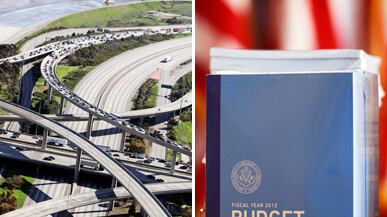In my favorite spaghetti western, The Good, the Bad and the Ugly, there is a memorable scene that sums up the world economy today. Blondie ( Clint Eastwood) and Tuco (Eli Wallach) have finally found the cemetery where they know the gold is buried. Trouble is, they’re in a vast Civil War graveyard, and they don’t know where to find the loot. Eastwood looks at his gun, looks at Wallach, and utters the immortal line: “In this world, there are two kinds of people, my friend. Those with loaded guns … and those who dig.”
In the post-crisis economic order, there are likewise two kinds of economies. Those with vast accumulations of assets, including sovereign wealth funds (currently in excess of $4 trillion) and hard-currency reserves ($5.5 trillion for emerging markets alone), are the ones with loaded guns. The economies with huge public debts, by contrast, are the ones that have to dig. The question is, just how will they dig their way out?
The conventional wisdom holds that, aside from resorting to inflation or default, debts can be reduced only through belt-tightening austerity measures—some mixture of higher taxes and spending cuts. And yet politicians are notoriously leery of proposing hikes or cuts big enough to make a real dent in the debt. President Obama’s latest budget proposal includes a five-year freeze on non-defense discretionary spending and tax increases on higher earners. But even if all goes according to plan, the gross debt will still rise above 105 percent of gross domestic product—and stay there.
ADVERTISEMENT
The root of the problem is, of course, a lack of political will, extending down from the president himself to the lowliest Tea Party activist living on Social Security and Medicare. But a convenient excuse for ongoing borrowing is also provided by Keynesian economic theory, which states that a fiscal squeeze will tend to reduce economic growth, thereby widening the gap between revenues and expenditures. Fiscal hawks respond that a bond-market panic induced by excessive borrowing could be even nastier.
We can’t sell Yellowstone or Yosemite. Those natural wonders should always belong to the nation. And not Alaska, much as many moderate Republicans would love to sell Sarah Palin to the Chinese.

Yet there is another fiscal option that neither party seems to be considering. The U.S. needs to do exactly what it would if it were a severely indebted company: sell off assets to balance its books.
There are three different arguments against such asset sales. The first concerns national security. When Dubai Ports World bought the shipping company P&O in 2006—which would have given it control of facilities in a number of U.S. ports—the deal was killed in Congress in a fit of post-9/11 paranoia. The second argument is usually made by unions: private or foreign owners will be tougher on American workers than good old Uncle Sam. Finally, there’s the chauvinism that surfaced back in the 1980s when the Japanese were snapping up properties like Pebble Beach. How could the United States let its national treasures—the family silver—fall into the hands of inscrutable Asian rivals?
Such arguments were never very strong. Now, in the midst of the biggest crisis of American public finance since the Civil War, they simply collapse. First, standards of public safety and security are unlikely to be compromised by a change of ownership unless military technology is involved (and the U.S. has already sold a startling amount of that to foreigners, by the way). Second, the goal of public policy should not be to protect public-sector workers from market discipline that will raise their productivity. Finally, why is selling assets to Asians worse than paying them an annual rent called interest on the national debt?
The mystery is why freedom-loving Americans are so averse to privatization—a policy that has been a huge success nearly everywhere it’s been tried. From Margaret Thatcher’s Britain, where the word “privatization” was coined, to present-day China, selling off government-owned industries has not only improved the fiscal position of governments; it has usually enhanced the efficiency with which the sold assets are managed.
The figures are impressive. Since the 1990s, about 75,000 medium-to-large firms have been privatized all around the world, from Argentina to Zambia, as have hundreds of thousands of smaller enterprises. The total proceeds: $735 billion. The United States accounts for only a tiny fraction of that number. Other countries are miles ahead. On a visit to Beijing in November last year, I even heard a leading Chinese economist half-seriously recommend the privatization of the Great Hall of the People. Yet American fiscal reformers—including the boldest of them, Republican Rep. Paul Ryan—tend to steer clear of the P word.
So let’s get down to business. What can the U.S. federal government and the various bankrupt states put up for sale? No, not Yellowstone or Yosemite. Those natural wonders should always belong to the nation. And no, not Alaska, much as many moderate Republicans would love to sell Sarah Palin to the Chinese.
In fact, the U.S. government currently has about $233 billion worth of non-defense “property, plant, and equipment,” according to the Treasury’s Financial Management Service. That is almost certainly an understatement. The government owns somewhere between 600 million and 700 million acres of land, or about 30 percent of the country’s land surface, much of it in the Western states, where as much as half the land is federally owned.
Washington could also sell its stakes in the Southeastern Power Administration and related assets as well as the Tennessee Valley Authority’s electric-power assets. There’s Amtrak (which runs at a loss) and the extensive hydroelectric empire of the U.S. Army Corps of Engineers.
And then there are the assets that have the potential to be among the most lucrative of all: America’s highways. Plenty of other countries—Japan, Turkey, and even China, to name just three—have already privatized substantial parts of their transportation infrastructure, leaving private companies to manage both revenues and maintenance.
American highways sold to foreign investors? It may sound unthinkable, but it’s already happening. Indiana recently leased the operation of the state’s principal 157-mile highway to a consortium led by the Spanish company Cintra and the Australian investment bank Macquarie. For the next 75 years, the consortium will collect the tolls from motorists. Indiana got $3.85 billion upfront. The city of Chicago has done a similar deal, leasing out its Skyway toll bridge for $1.83 billion. A few other state governments have been moving hesitantly down this same path, usually by setting up public-private partnerships to manage stretches of highway.
But there’s so much more that could be done. California’s government has an estimated $103 billion in assets, including state highways with a book value of $59 billion. Are you telling me a sovereign wealth fund from, say, Singapore couldn’t do a better job of running those choked and often potholed roads? Yet one of Gov. Jerry Brown’s first acts since returning to office was to cancel a planned privatization of state-owned office buildings.
From sea to shining sea, American politicians are running scared from the only credible solution to the country’s fiscal crisis. Rather than publishing honest balance sheets with meaningful valuations of both their assets and liabilities, they’d rather maintain the fiction that it’s their job to invest billions in high-speed railroads and the like.
Let’s face it: if you want to see serious investment in America’s infrastructure—and the American Society of Civil Engineers estimates that a full upgrade would cost $1.3 trillion—it isn’t going to come from the likes of Governor Brown, much less President Obama. They’re broke, folks.
There are, remember, two kinds of economies in this world: those with guns and those who dig—those with piles of cash and those with mountains of debt. Sure, the debtors can keep on borrowing until their creditors revolt, or they can try to dig their way out with austerity budgets. But a better idea would be to get smart and start inviting bidders to what could be the sale of the century.
Niall Ferguson is a professor of history at Harvard University and a professor of business administration at Harvard Business School. He is also a senior research fellow at Jesus College, Oxford University, and a senior fellow at the Hoover Institution, Stanford University. His latest book, The Ascent of Money: A Financial History of the World, was published in November.





